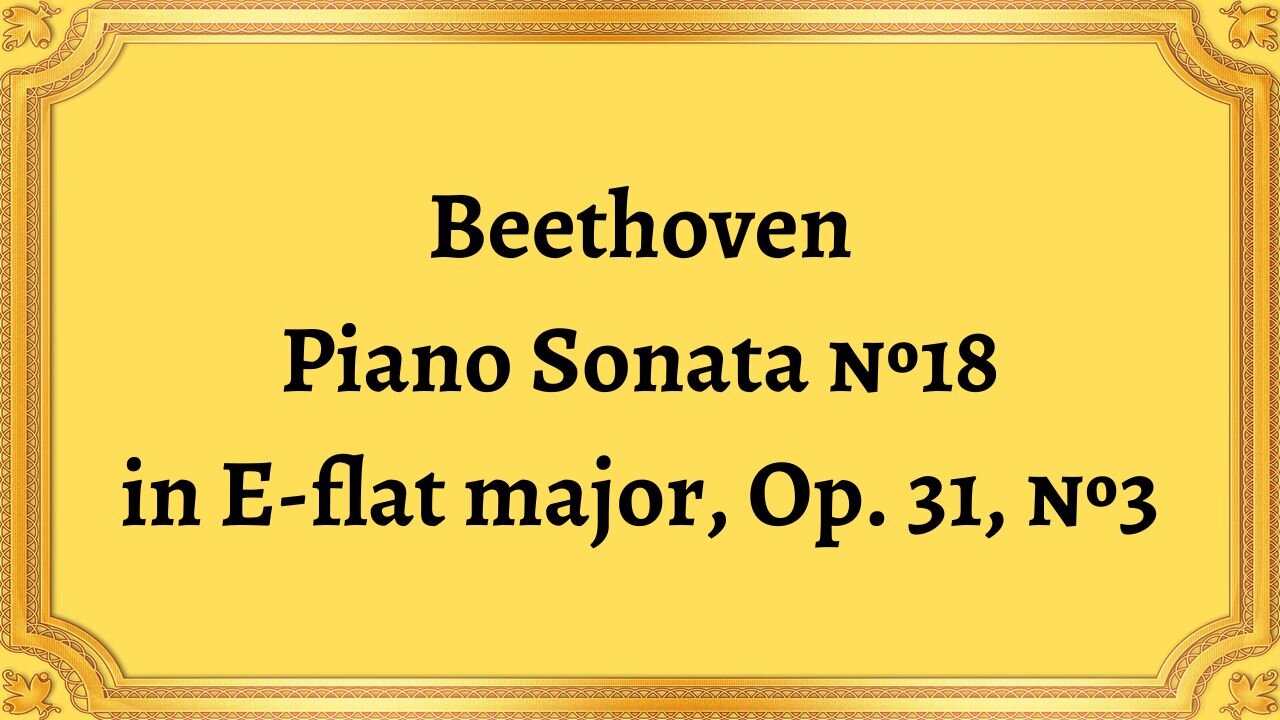Premium Only Content

Beethoven Piano Sonata №18 in E-flat major, Op. 31, №3
#classical_music #Beethoven #sonata_for_piano
Beethoven Piano Sonata No. 18 in E-flat major, Op. 31, No. 3 is a captivating masterpiece composed by Ludwig van Beethoven, a towering figure in classical music. This remarkable piece, known for its technical virtuosity and harmonic complexity, represents a pivotal moment in Beethoven's musical evolution.
Beethoven composed Piano Sonata No. 18 in E-flat major, Op. 31, No. 3 between 1802 and 1803. This period is often referred to as Beethoven's middle period or heroic period, characterized by the composer's increasing exploration of new musical ideas and techniques. During this time, Beethoven's revolutionary spirit and his struggles with deafness fueled his creative endeavors, resulting in groundbreaking compositions.
Beethoven's Piano Sonata No. 18 adheres to the traditional three-movement structure of a classical sonata: Allegro, Scherzo, and Menuetto. The sonata form provides a framework for Beethoven's musical ideas, allowing for both coherence and experimentation within each movement.
This sonata showcases Beethoven's daring approach to harmony. He ventures beyond the conventions of the time, employing bold and unexpected chord progressions, modulations, and tonal explorations. These harmonic innovations create a sense of tension, unpredictability, and emotional depth that distinguishes Beethoven's composition.
Piano Sonata No. 18 demands technical mastery from the performer, featuring intricate passages, rapid scale runs, and leaps across the keyboard. Beethoven's pianistic writing challenges the limits of technique, elevating the sonata to a virtuosic level while maintaining expressive depth.
The sonata's movements exhibit a wide range of emotions. The first movement, Allegro, opens with a spirited and lively theme, juxtaposing energetic passages with moments of introspection. The Scherzo movement displays a playful and whimsical character, while the Menuetto movement brings a graceful and elegant atmosphere, showcasing Beethoven's ability to evoke diverse moods.
Beethoven's Piano Sonata No. 18 in E-flat major, Op. 31, No. 3 holds a prominent place in the classical music repertoire due to its enduring significance:
Beethoven's harmonic language in this sonata paved the way for future composers, inspiring generations of musicians to explore new tonal territories and experiment with harmony in their own compositions.
The technical challenges presented in Piano Sonata No. 18 have made it a staple in piano repertoire, inspiring pianists to hone their skills and push the boundaries of their own abilities. Its virtuosic demands continue to captivate audiences and showcase the immense talent of performers.
Beethoven's ability to convey a range of emotions in this sonata resonates with listeners on a profound level. The interplay between technical brilliance and deep expressiveness has made this composition a cherished favorite among music enthusiasts.
Beethoven Piano Sonata No. 18 in E-flat major, Op. 31, No. 3 stands as a testament to Ludwig van Beethoven's innovation, technical prowess, and emotional depth. Its harmonic complexities, technical virtuosity, and expressive range continue to captivate audiences and inspire musicians.
-
 24:35
24:35
Classical music_Music Inspiration
22 days agoMax Bruch Violin Concerto No. 1 in G minor, Op. 26
871 -
 5:30:10
5:30:10
SpartakusLIVE
12 hours ago#1 Verdansk Sniper gets HACCUSATIONS because of INSANE Headshots
58K4 -
 46:18
46:18
SB Mowing
2 days agoShe was LOSING HOPE but this SURPRISE CHANGED EVERYTHING
46.1K44 -
 10:00:10
10:00:10
ItsLancOfficial
12 hours agoWE LIVE 🔴WE LIVE 🔴 SUNDAY SUNDAYS!!!!!!! TARKOV
38.5K1 -
 4:09:32
4:09:32
EricJohnPizzaArtist
6 days agoAwesome Sauce PIZZA ART LIVE Ep. #59: Are You Ready for some FOOTBALL with GameOn!
46.7K7 -
 1:21:43
1:21:43
Jake Shields' Fight Back Podcast
17 hours agoJake Shields and Paul Miller!
78.6K137 -
 1:20:41
1:20:41
TRAGIKxGHOST
9 hours agoTrying to get SCARED tonight! | Are You SCARED!? | Screams Beyond Midnight | Grab a Snack
29.4K5 -
 5:21:24
5:21:24
StuffCentral
10 hours agoI'm baaack (no you can't play with me.. unless you a healer)
28.4K6 -
 2:25:11
2:25:11
TheSaltyCracker
12 hours agoTrump Is Not Dead ReEEeStream 8-31-25
109K169 -
 3:09:16
3:09:16
THOUGHTCAST With Jeff D.
10 hours ago $6.49 earnedLabor Day Weekend FORTNITE With THOUGHTCAST Jeff & the squad
29K4